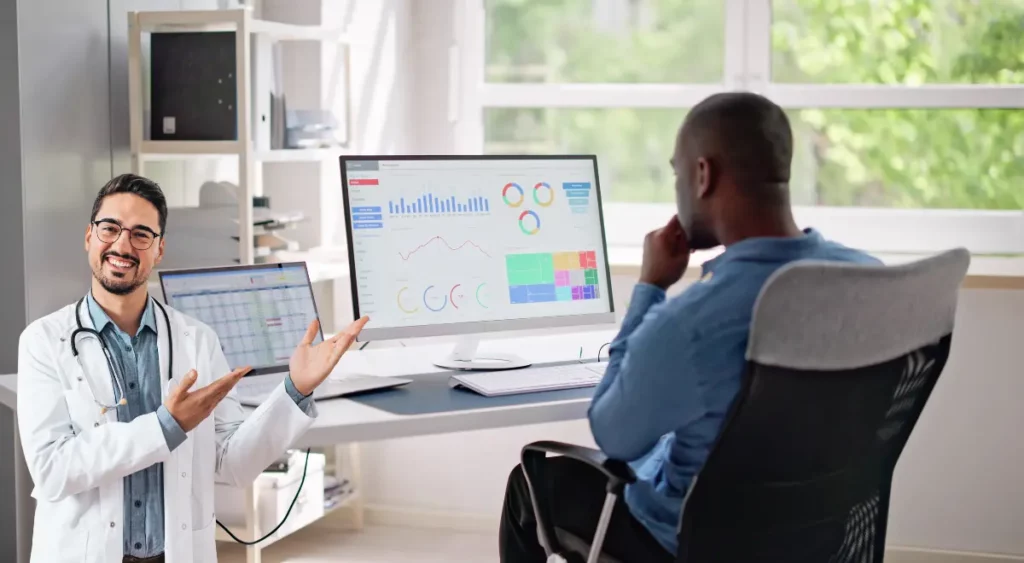Common RPM Pricing Models for Providers: A Profitability-Focused Guide

Remote Patient Monitoring (RPM) has rapidly emerged as one of the leading programs for providers trying to improve patient outcomes while generating the most stable and recurring revenue stream. With Medicare and many private insurers reimbursing rates between $120 and $200 per patient per month, a good RPM program can make a substantial difference in the financial well-being of a practice.
However, the truth is that not all RPM pricing models are alike. The way you set up your RPM program, whether relying a lot on a vendor or if everything is handled internally, will dictate your practice’s profit margins, operational burden, and future scalability of the program.
Let’s take a look at the four most popular RPM pricing models, thoroughly examining how they function, the cost of implementation, and ultimately, what they mean for your practice’s bottom line.
Table of Contents
ToggleA. Turnkey Vendor Model
The turnkey vendor model is the lowest-touch model for providers. In this model, the vendor takes responsibility for all aspects of the RPM program. They provide everything to get your program launched, including the monitoring devices, which are FDA-approved (i.e., blood pressure cuffs, glucose meters, scales, etc.), a software platform to transmit data that is HIPAA compliant for all reporting and connectivity purposes, and, lastly, they provide clinical staff to monitor patients.
- The vendor provides all devices, software, and monitoring staff.
- Flat fee or a desired % of reimbursement earned (e.g., 70/30).
- Low provider involvement and improved scalability.
- Lower margins for delivery and less control.
This means the provider’s role is straightforward: identify and enroll eligible patients. The vendor team then handles daily monitoring, reviewing vitals, interacting with patients when readings go outside of defined parameters, and documenting the time spent for any potential CMS billing requirements.
From a financial standpoint, a turnkey program typically uses either a flat fee for every enrolled patient or a flat revenue share. In a revenue share arrangement, the reimbursement is then split, either 70/30 or 80/20, to the provider. If, for example, CMS were to reimburse $150 per patient each month, you might keep $105 while the vendor company keeps $45.
Ultimately, the big incentive here is ease of use. For instance, a small primary care clinic could implement RPM for 100 patients and would not have to hire staff or build any type of infrastructure. The downside of ease is that it comes with lower profit margins and limitations on the control over your patient interactions. You are relying upon an outsourcing team to represent your practice, which not only might be less personalized to patients but also potentially jeopardizes the continuity of care.
The turnkey RPM model is a solid option for any provider looking to launch RPM quickly, especially if they do not have the staff capacity to exempt those associated roles. It generates a steady new stream of revenue while only having nominal operational burdens.
B. Hybrid Model
The hybrid model is frequently viewed as the best compromise between vendor assistance and provider independence. In the hybrid model, the vendor is still providing the devices and the software platform, but your institution’s internal staff is monitoring patients, communicating with patients, and documenting time for billing.
What does that look like? Rather than offloading everything to an outside call center or nursing staff, your medical assistants, nursing staff, or care coordinators are reviewing vitals daily and reaching out if needed. Patients enjoy hearing from a familiar voice, and your practice has full visibility into the workflows, escalations, and quality of care.
- Provider utilizes vendor platform and devices, but monitors with its own staff.
- Platform + device fee with lower operational costs.
- Better ROI and higher control on the dashboard.
- Internal resources needed.
From a monetary perspective, this model is more profitable than turnkey because you are not paying the vendor part of your reimbursement. You simply pay device costs (often per patient) and platform licensing fees, which can be billed per provider or per patient per month. Since you are doing the monitoring, your margins stay higher. For example, if you are getting reimbursed $150 per patient and vendor costs are $30 for the patient, you net $120, which is a greater take-home than the previous example under turnkey.
As a whole, the use of a hybrid approach resonates well with practices that want to achieve greater profitability while still taking advantage of vendor-driven technology and logistics. This model allows the practice to maximize the equilibrium of control, scalability, and patient engagement while still requiring a certain buy-in or commitment from the practice internally.
C. In-House / Do-It-Yourself (DIY) Model
The DIY model is the most independent and profitable model for providers. Under this model, the provider organization assumes total responsibility for every component of the RPM program. Devices are bought from the manufacturers, RPM software platforms are either fully developed in-house or are seamlessly integrated with the existing EHR, and monitoring can be done completely in-house.
This model elevates RPM from just a service that benefits your patients to a service line that is a true internal service line. You can create workflows that integrate with your clinical workflow, you can brand the program with your name, and you can keep all revenue generated by the RPM program. For example, if CMS independently reimburses you $150-200 per patient, for each patient under management, nearly all of those dollars are going to be kept by your practice, less the fixed costs associated with maintaining technology and payroll for staff.
- Provider purchases devices and utilizes existing workflows and clinical processes.
- Highest start-up cost but lowest operational fee.
- Controls reimbursement and allows creating a customized workflow.
- Technology infrastructure and clinical bandwidth are needed.
The upside is clear; profits are maximized! An example of a health system managing 1,000 patients could be looking at net monthly RPM revenue of $140,000-$180,000. That is a multi-million-dollar opportunity over the course of a year!
But these difficulties can be considerable. Establishing a DIY program often includes large capital expenses, usually tens of thousands of dollars for devices, IT infrastructure, and support staff training. Even then, the operating expenses will include salaries for the staff, patient compliance management, and technology upkeep. Also, building a program takes time. It is not unusual for a (DIY) RPM system to develop over several months to put the different pieces together.
This model is best suited for larger organizations such as hospitals or Accountable Care Organizations (ACOs), which already have considerable clinical infrastructure as well as IT infrastructure already established. For those providers, RPM becomes a planned initiative whose use grows over time.
D. Subscription (Per Patient Per Month- PPPM) Model
The subscription model is one of the simplest payment types available in RPM. This method charges providers a straightforward monthly fee per patient, typically $40 – $80 in the range that covers devices and/or services, platform access, and, in some instances, monitoring services.
This model is fairly simple for providers to understand: you know exactly how much each patient costs on a monthly basis, and you can easily calculate profit margins. Since CMS reimbursement is between $120 and $200 per patient per month, generally, you have a net profit of between $40 and $160 per patient after vendor fees and costs.
- This subscription-based model comes with vendor charges: $40-$80 (PPPM) per patient for full service (device, platform, monitoring)
- Provider bills CMS: $120-$200 per patient.
- Profit margin: $40-160 PPPM.
For example, if your vendor charges $60 PPPM, and you bill $160 PPPM, then your profit margin is $100 per patient. If you have 500 patients, that becomes $50,000 net per month. The scalability is straightforward and predictable, which is attractive for practices looking to dip their toe into RPM without being too risky.
The negatives with this model are limited flexibility and capped margins, since you will be locked into the vendors’ fee structure and limited in the amount of profit you can deliver and realize. Depending on your vendor, scaling up to more patients can be limited, and also customizing workflows can sometimes be non-existent.
That said, the subscription model may be the best fit for small to mid-sized practices that want a quick and smooth entry into RPM. Predictable and profitable, the subscription RPM model can deliver a very clear financial path for RPM growth without any heavy start-up costs otherwise found in the consultant or billable model.
Which RPM Model Delivers the Best Profitability For Healthcare Providers?
The fact is that profitability is somewhat subjective and dependent on the size of the practice, the population of patients, and resources.
- Turnkey models are the quickest to implement but provide the lowest margins. It is a good approach for small clinics just getting started with remote monitoring. The profitability for 500 enrolled patients at an average reimbursement amount of $150 for a Turnkey Model is $52,500 net monthly revenue.
- Hybrid models are in the middle; they provide better ROI while also only requiring partial vendor support. The profitability for 500 enrolled patients at an average reimbursement amount of $150 for a Hybrid Model is $60,000 net monthly revenue.
- DIY models are the gold standard of profitability but require significant investment and organizational commitment. The profitability for 500 enrolled patients at an average reimbursement amount of $150 for a DIY Model is $75,000-$90,000 net monthly revenue.
- Subscription models are easy and predictable, best suited for practices that are looking for a safe and scalable first step. The profitability for 500 enrolled patients at an average reimbursement amount of $150 for a Subscription Model is $40,000-$80,000 net monthly revenue.
What Providers Need to Keep in Mind in Terms of RPM Profitability?
For providers, RPM is more than just a compliance driven program; it is a financial strategy. The pricing model selected may determine if RPM is a supplemental revenue stream or a primary service line with revenue in the six or seven figures range annually.
- If your goal is to get started quickly with minimal disruption → select Turnkey or Subscription.
- If your goal is increased profitability with minimal vendor involvement → select Hybrid.
- If your organization is prepared to fully embrace RPM as a long-term service line → select the DIY model.
The only thing you need to determine is how you align your pricing model with your practice’s ability to offer staffing, IT, and even patient engagement, as well as your financial expectations. Once you create that alignment with RPM, you will be able to achieve better patient outcomes and ongoing recurring revenues.
Conclusion
Remote Patient Monitoring has shifted from an optional enhancement to a strategic, revenue-generating service line that can reshape how providers deliver care. As CMS reimbursement continues to support RPM through consistent monthly payments of $120–$200 per patient, the pricing model you choose becomes the single greatest determinant of your program’s profitability, scalability, and operational efficiency.
Each RPM model comes with clear advantages: Turnkey models offer unmatched convenience, Subscription models provide predictability, Hybrid models strike the ideal balance between control and profitability, and DIY approaches unlock the highest long-term financial return. Ultimately, the best model depends on your organization’s readiness—your staffing resources, IT infrastructure, patient population, and financial appetite for investment.
What matters most is alignment. When your RPM pricing model aligns with your clinical workflow, team capabilities, and revenue expectations, RPM evolves into far more than a reimbursement opportunity—it becomes a powerful tool to improve outcomes, reduce unnecessary utilization, and build a sustainable recurring revenue engine. Providers who make thoughtful, data-driven decisions today will be the ones best positioned to scale RPM
Frequently Asked Questions (FAQs)
The four major RPM pricing models are
- Turnkey Vendor Model
- Hybrid Model
- In-House/DIY Model
- Subscription (Per Patient Per Month) Model
Each model affects scalability, margins, staffing needs, and operational control differently.
Q: Which RPM model is most profitable?
The DIY model is the most profitable long-term because providers retain nearly all reimbursement revenue, minus internal staffing and technology expenses.
Q: Which model is best for beginners?
The Turnkey or Subscription models are the most suitable for beginners, as they require minimal staff involvement and provide quick deployment.
In the turnkey model, the vendor provides:
- RPM devices
- Software platform
- Clinical monitoring staff
- Documentation for CMS billing
The provider only identifies and enrolls eligible patients.
Q: What are the financial pros of turnkey RPM?
- Easiest to launch
- Scalable with almost no provider overhead
- Predictable monthly revenue
Q: What are the drawbacks?
- Lowest profit margins
- Limited control over patient interactions
- Outsourced staff may affect patient experience.
Q: What does a typical revenue split look like?
Common vendor splits are 70/30 or 80/20, meaning providers keep 70–80% of RPM reimbursement.
The hybrid model blends vendor technology/devices with internal clinical monitoring. Providers use vendor tools but handle all patient communication, monitoring, and documentation internally.
Q: Why do practices prefer hybrid?
- Higher profitability than turnkey
- Better control over patient experience
- Familiar staff monitor patients, improving trust.
Q: What is the cost structure?
- Device fees (per patient)
- Platform licensing
- No revenue share
This model nets significantly higher margins.
Q: For whom is the hybrid model best suited?
This model is best suited for practices that have some staff capacity and seek a balance between ease of implementation and profitability.
In the DIY model, providers manage every part of RPM internally:
- Buy devices directly
- Develop or integrate RPM software
- Use internal staff for monitoring
- Manage logistics, documentation, and billing
Q: What are the advantages of DIY?
- Maximum profit retention
- Fully customized workflow
- Complete control over patient care
- Long-term revenue scalability
Q: What are the challenges?
- Significant startup investment
- High staffing responsibility
- Requires IT and workflow readiness
Q: Which organizations benefit the most?
Large health systems, ACOs, and hospitals with existing clinical infrastructure are the organizations that benefit the most.
Providers pay a fixed per-patient monthly fee (typically $40–$80) that covers devices, software, and sometimes monitoring. Providers then bill CMS ($120–$200 per patient per month).
Q: Why is the subscription model popular?
- Simple cost structure
- Easy profit forecasting
- Low startup cost
- Fast implementation
Q: What is the typical profit margin?
Providers keep $40–$160 per patient monthly after vendor fees. With 500 patients, this rate equates to $40,000–$80,000 per month.
Q: What are the limitations?
- Vendor-set pricing caps profits.
- Limited flexibility
- Workflow customization may be restricted
RPM reimbursement ranges from $120 to $200 per patient per month depending on CPT codes used.
Q: What does profitability look like for 500 patients?
- Turnkey: ~$52,500 net/month
- Hybrid: ~$60,000 net/month
- DIY: ~$75,000–$90,000 net/month
- Subscription: ~$40,000–$80,000 net/month
Q: Why do margins vary so much?
- Vendor fees
- Staffing costs
- Device logistics
- Technology investments
- Level of internal vs. outsourced support
- Staffing availability
- IT readiness
- Patient volume
- Cash flow capability
- Need for control vs. convenience
- Long-term revenue expectations
Q: What if a provider wants quick implementation with minimal work?
Turnkey or Subscription is ideal.
Q: What if profitability is the main priority?
Should mid-sized practices opt for a hybrid approach, or should large organizations opt for DIY?
- Turnkey: Very low startup cost
- Hybrid: Low–moderate
- Subscription: Almost no startup, predictable monthly expense
- DIY: High startup (devices, tech, staff)
Q: Are devices purchased or rented?
- Turnkey: vendor supplies
- Hybrid: vendor supplies
- Subscription: included
- DIY: purchased upfront
Q: Do RPM devices need to be FDA-approved?
Yes. All devices used for CMS-billable RPM must be FDA-cleared.
Turnkey Risks
- Lower margins
- Outsourced patient care
- Vendor dependency
Hybrid Risks
- Requires staff bandwidth
- More internal oversight is needed.
DIY Risks
- High upfront investment
- Complex to build
- Staffing and IT burden
Subscription Risks
- Limited flexibility
- Profitability capped
Q: How can providers reduce RPM risk?
- Start with a hybrid/subscription.
- Gradually scale up to DIY.
- Train internal staff deeply
- Use a modern RPM platform with automation
A well-run RPM program may generate six to seven figures per year, depending on patient volume and pricing model.
Q: What size does a practice need to be to earn $1M+ annually?
A practice needs to have 500–800 active RPM patients, depending on the business model and reimbursement rates, to earn $1M+ annually.
Q: Can RPM become a primary revenue line?
Yes. Many organizations treat RPM as a core service line with recurring monthly income.
- Choosing turnkey without understanding low margins
- Underestimating staffing needs for hybrid/DIY
- Ignoring device logistics and patient onboarding
- Choosing a vendor without workflow flexibility
- Not projecting long-term net revenue
Q: How do you avoid overpaying vendors?
- Compare subscription PPPM fees
- Avoid revenue sharing when possible.
- Negotiate for volume discounts
- Turnkey: fastest to scale, lowest effort
- Hybrid → scalable with proper staffing.
- DIY: highly scalable, long-term, but slow to build.
Q: Which model scales best financially?
DIY → Highest income retention as patient volume increases.
- Turnkey: 1–2 weeks
- Subscription: 2–4 weeks
- Hybrid: 3–6 weeks (training required)
- DIY: 2–6 months depending on IT readiness
Q: Which model has the shortest onboarding period?
Turnkey
Q: Which model has the longest training requirement?
DIY (internal staff + technical setup)
- Enroll eligible patients
- Document a clinical need.
- Provide oversight
- Ensure billing compliance
- Track performance metrics
Q: Can vendors completely replace provider care?
No. CMS requires provider oversight, even in turnkey models.
Q: Who is responsible for billing documentation?
Turnkey: vendor documents, provider bills
Hybrid/DIY: provider documents and bills
Subscription: varies by contract
Most Recent Blogs
Categories
Related Blog
- October 23, 2025 | Read Time: 12 mins
How RPM Devices Improve Hypertension and Diabetes Outcomes in Medicare Populations
Remote patient monitoring (RPM) is transforming chronic care for Medicare beneficiaries. CMS...
Learn More- August 25, 2025 | Read Time: 13 mins
How Can “One Big Beautiful Bill” Boost RPM Programs by $50B?
The “One Big Beautiful Bill,” signed July 4, 2025, directs $50B over...
Learn More- August 22, 2025 | Read Time: 17 mins
HealthArc Platform vs RPM Software Solutions
Is your healthcare organization trying to pick a remote patient monitoring solution?...
Learn More


